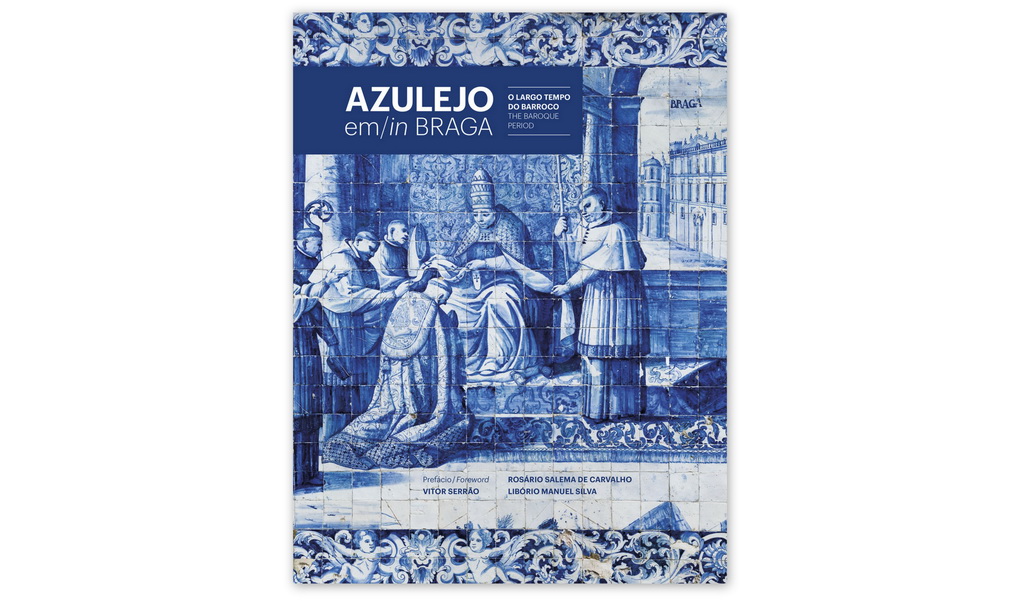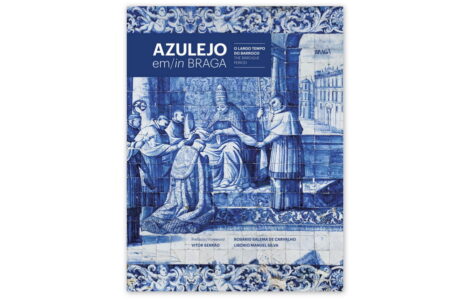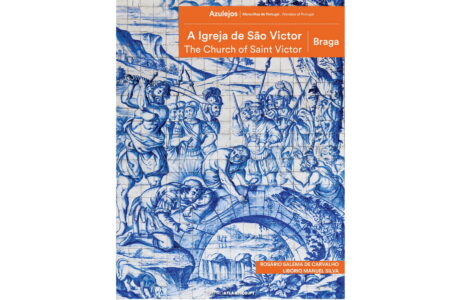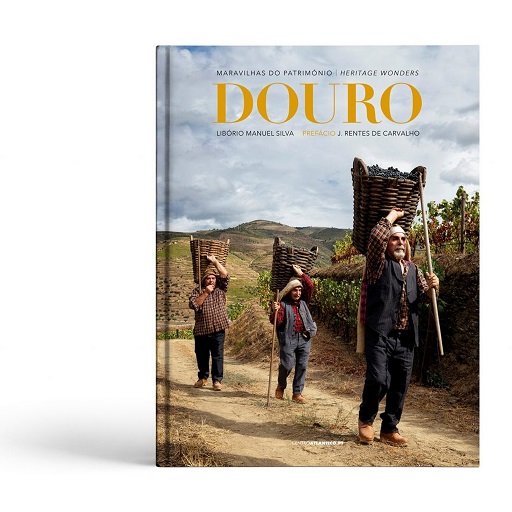Descrição
Envio a efectuar via CTT com portes gratuitos (directamente pela editora para a morada indicada para entrega).
Prazo previsto: Estima-se um prazo de 2 até 5 dias úteis após a data de envio para o cliente receber a encomenda.

Azulejo em/in Braga – O Largo Tempo do Barroco / The Baroque Period
Coordenação e Fotografia/Coordination and Photography:Libório Manuel Silva
Texto/Text: Rosário Salema de Carvalho
Prefácio/Foreword: Vitor Serrão
Págs: 216 (em capa dura/hardcover, 24,5cm * 32,1cm)
ISBN: 978-989-615-211-6
1.ª edição/1st edition: Set/Sep, 2016
«Conhecer melhor o património artístico da cidade, e os seus azulejos produzidos durante a Idade Moderna, passa inevitavelmente pela lição deste livro»
«The aim of this book is to offer an insight into Braga’s artistic heritage and an overview of the city’s azulejos produced during the Modern Age.»
Prof. Doutor Vitor Serrão

«É esplendoroso o resultado desta íntima colaboração entre o olhar da Fotografia e a visão analítica da História da Arte, porque nos permite constatar, através de páginas belíssimas e esclarecedoras, aquilo que parecia ser já uma evidência e que agora melhor se comprova através das cerca de três dezenas de conjuntos estudados: a cidade de Braga conserva um dos maiores e mais notáveis acervos de azulejaria da época barroca que existem no país.»
«The result of this intimate collaboration, combining the visual approach of Photography and the analytic approach of Art History, is astounding. A series of beautiful and illuminating pages point out what already seemed obvious, but is now confirmed by the analysis of twenty seven decorative ensembles: the city of Braga harbours one of Portugal’s widest and most remarkable collections of Baroque azulejos.»
Prof. Doutor Vitor Serrão
Aplicado sem interrupções há mais de cinco séculos, o azulejo é uma das expressões artísticas que mais distingue o património cultural português. A relação privilegiada que desde sempre estabeleceu com a arquitectura e com as outras artes confere-lhe um papel cimeiro na organização dos interiores de igrejas e palácios constituindo, mais tarde, um elemento diferenciador na paisagem urbana de tantas vilas e cidades do país.
|
Used uninterruptedly for more than five centuries, the azulejo is one of the most distinctive elements of Portugal’s cultural heritage. Due to its privileged relationship with the architecture and other art forms, it has played a central role in the organization of church and palace interiors, and went on to become an important part of the urban landscape of many towns and cities throughout the country.
|
AUTORES / AUTHORS
| Rosário Salema de Carvalho é investigadora do ARTIS – Instituto de História da Arte da Faculdade de Letras da Universidade de Lisboa, onde integra o grupo Az – Rede de Investigação em Azulejo, da qual é também coordenadora executiva. Actualmente desenvolve um projecto de pós-doutoramento (com bolsa da Fundação para a Ciência e a Tecnologia), dedicado à questão das molduras no azulejo barroco, tendo como instituição de acolhimento o ARTIS (Az) e o Museu Nacional do Azulejo. É doutorada em História, especialidade em História da Arte, pela Faculdade de Letras da Universidade de Lisboa (2012), com a tese intitulada A pintura do azulejo em Portugal [1675-1725]. Autorias e biografias – um novo paradigma. Em 2007 defendeu o Mestrado em Arte, Património e Restauro, na mesma faculdade, com a dissertação …por amor de Deus. Representação das Obras de Misericórdia, em painéis de azulejo, nos espaços das confrarias da Misericórdia, no Portugal setecentista. Tem desenvolvido investigação na área do património e, principalmente, na área da Azulejaria Portuguesa, com vários artigos publicados em revistas científicas nacionais e internacionais. |
Libório Manuel Silva é editor do Centro Atlântico, empreendedor e um grande apaixonado por fotografia de cultura e património. É autor de cerca de 30 livros – em três editoras – sobre História do Livro, Arte, Fernando Pessoa, Gestão e Tecnologias, e de mais de 100 artigos publicados nos principais jornais e revistas portugueses. Fundou e dirigiu três revistas. Fruto de um longo trabalho de investigação, prepara a publicação do segundo volume deBibliotecas – Maravilhas de Portugal /Libraries – Wonders of Portugal, a sua obra seminal, bem como de Azulejos – Maravilhas de Portugal / Wonders of Portugal. Em Portugal, foi precursor da formação em Internet (1994) e da criação e distribuição de e-books (1999). Tem dez anos de experiência como docente no ensino superior, uma pós-graduação em Gestão, uma outra, internacional (EUA, França, Coreia do Sul e Japão), em Excelência nos Serviços e ainda a frequência num MBA de Comércio Internacional. Começou a fotografar muito cedo, tendo recebido formação na Cooperativa Árvore, o que o motivou para a criação de um laboratório fotográfico doméstico. É editor dos livros sobre fotografia mais vendidos em Portugal. Os seus dois filhos são a sua principal fonte de inspiração. |
| Rosário Salema de Carvalho, researcher at ARTIS – Art History Institute of the Faculty of Letters of the University of Lisbon, and executive coordinator of the Az – Azulejo Research Network, currently developing a post-doctoral project (awarded by Foundation for Science and Technology), dedicated to the issue of frames in Baroque tile decorations, hosted by ARTIS (Az) and the National Azulejo Museum. The author has a PhD in History, with a specialisation in Art History, from the Faculty of Letters of the University of Lisbon (2012) and wrote a dissertation entitled Azulejo painting in Portugal[1675-1725]. Authorships and biographies – a new paradigm. She concluded in 2007 a Master’s Degree in Art, Heritage and Restoration from the same Faculty, with the dissertation …for the love of God. The depiction of the works of mercy in 18th century Portuguese tile panels commissioned by the Brotherhoods of Mercy. Currently focused on the study of artistic heritage, and particularly on the field of Portuguese azulejos, Rosário Salema de Carvalho is the author of several articles published in national and international scientific journals. |
Libório Manuel Silva, founding editor of Portuguese publisher Centro Atlântico (the national best-seller photography books publisher), is an entrepreneur with a great love of cultural and heritage photography. The author of some thirty books – with three different publishers – on subjects such as the History of the Book, Art, Fernando Pessoa, Management and Technology, and over one hundred articles published in leading Portuguese newspapers and magazines. He both founded and directed three magazines. Presently Libório Manuel Silva is preparing for publication Azulejos – Wonders of Portugal and the second volume of his seminal work: Libraries – Wonders of Portugal, the culmination of extended research. In Portugal, he is known as a pioneer of Internet training (1994) and of the creation and distribution of e-books (1999). With ten years’ experience as a teacher in higher education, he holds a postgraduate qualification in Management, an international postgraduate certificate (USA, France, South Korea and Japan) in Service Excellence, and he attended an MBA in International Commerce. Libório Manuel Silva took up photography at very young age and following study at the Cooperativa Árvore in Oporto, he created a photographic laboratory at home. His two sons are his main source of inspiration. |












